人教英语必修一Unit1Friendship教案3
人教版高中英语必修一 Unit1 Friendship 教案
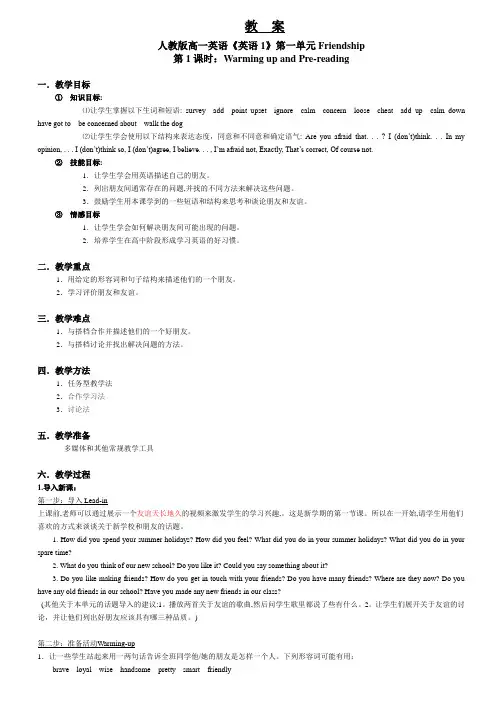
教案人教版高一英语《英语1》第一单元Friendship第1课时:Warming up and Pre-reading一.教学目标①知识目标:⑴让学生掌握以下生词和短语: survey add point upset ignore calm concern loose cheat add up calm down have got to be concerned about walk the dog⑵让学生学会使用以下结构来表达态度,同意和不同意和确定语气: Are you afraid that. . . ? I (don’t)think. . . In my opinion, . . . I (don’t)think so, I (don’t)agree, I believe. . . , I’m afraid not, Exactly, That’s correct, Of course not.②技能目标:1.让学生学会用英语描述自己的朋友。
2.列出朋友间通常存在的问题,并找的不同方法来解决这些问题。
3.鼓励学生用本课学到的一些短语和结构来思考和谈论朋友和友谊。
③情感目标1.让学生学会如何解决朋友间可能出现的问题。
2.培养学生在高中阶段形成学习英语的好习惯。
二.教学重点1.用给定的形容词和句子结构来描述他们的一个朋友。
2.学习评价朋友和友谊。
三.教学难点1.与搭档合作并描述他们的一个好朋友。
2.与搭档讨论并找出解决问题的方法。
四.教学方法1.任务型教学法2.合作学习法3.讨论法五.教学准备多媒体和其他常规教学工具六.教学过程1.导入新课:第一步:导入Lead-in上课前,老师可以通过展示一个友谊天长地久的视频来激发学生的学习兴趣,。
这是新学期的第一节课。
所以在一开始,请学生用他们喜欢的方式来谈谈关于新学校和朋友的话题。
1. How did you spend your summer holidays? How did you feel? What did you do in your summer holidays? What did you do in your spare time?2. What do you think of our new school? Do you like it? Could you say something about it?3. Do you like making friends? How do you get in touch with your friends? Do you have many friends? Where are they now? Do you have any old friends in our school? Have you made any new friends in our class?(其他关于本单元的话题导入的建议:1。
人教版高中英语必修一教案Unit 1 Friendship (含答案)
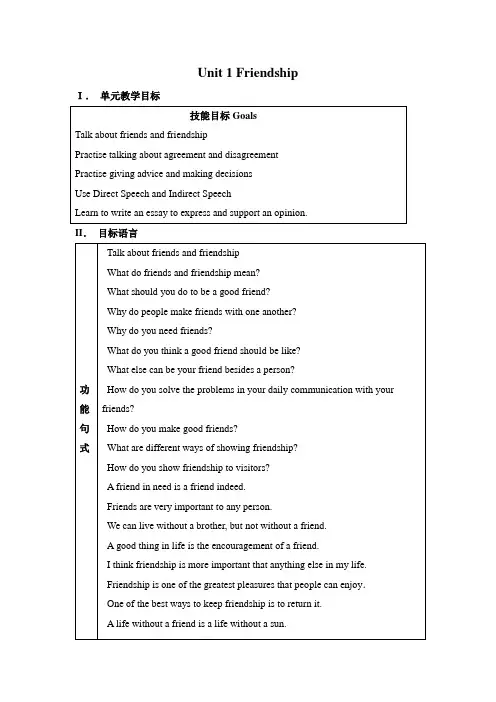
Unit 1 Friendship I.单元教学目标II.目标语言III. 教材分析和教材重组1. 教材分析本单元以Friend和Friendship为话题,旨在通过单元教学使学生通过讨论什么是好朋友,什么是真正的友谊,如何交友和保持友谊等问题,使学生树立正确的交友观。
并针对日常交友过程中经常遇到的实际问题,指导学生发表自己的见解和看法,通过进一步讨论提供有效的解决方案。
并能就此以编辑的身份写出指导信,对相关谚语写出观点明确、论证有力的短文。
1.1 Warming Up以调查问卷的形式,通过对学生在日常交友过程中所遇到的五个问题,展开调查,使学生对是否擅长交友做出评价,激发学生对本单元的中心话题产生兴趣;同时也使教师本单元的授课更具有针对性,从而有效地帮助学生树立正确的交友观。
1.2 Pre-Reading通过四个问题引导学生讨论交友的重要性以及自己心目中好朋友的概念和标准,并使学生认识到不仅人与人,人与物(如日记)也可以成为好朋友。
继续探究并树立正确交友观,并为阅读作好了准备。
1.3 Reading讲述第二次世界大战的纳粹统治时期,犹太人Anne一家过着滇沛流漓,与世隔绝的生活。
Anne在孤独中只能以日记Kitty 为友,倾诉衷肠,伴其渡过两年的逃亡生涯。
控诉了纳粹党的残暴统治给犹太人民带来了深重的灾难,并以日记的形式表达了以主人公Anne为代表的全世界人民憎恨战争渴望和平的共同心愿。
学生学习了新的词汇、句型,提高了阅读水平。
文中选用了主人公的一篇日记,使学生进一步感受到了挚友的可贵,对主人公内心世界的描写有了更深刻的理解。
1.4 Comprehension 设计了三种题型。
其中前两个是考查学生对READING文章细节内容的理解,最后一题是开放性问题,学生可以在更深入理解主人公内心世界的基础上各抒己见,使学生养成勤于思考勇于探究的良好的学习习惯,现时也培养了学生的想象力,进一步提高了阅读水平。
最新人教版高中英语必修一+Unit+1++Friendship全单元教案(精品)名师优秀教案
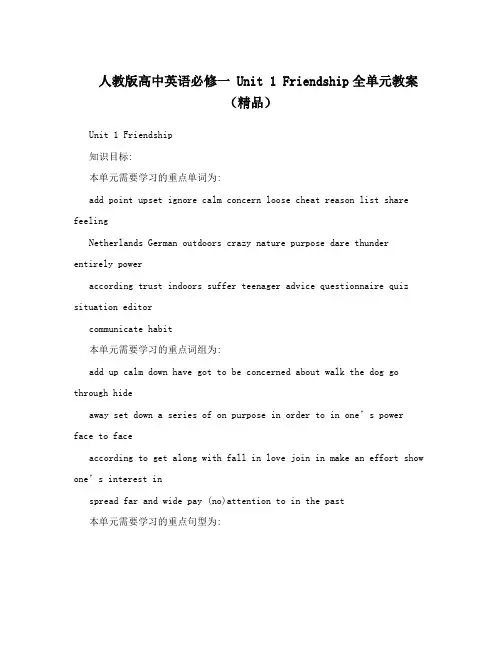
人教版高中英语必修一 Unit 1 Friendship全单元教案(精品)Unit 1 Friendship知识目标:本单元需要学习的重点单词为:add point upset ignore calm concern loose cheat reason list share feelingNetherlands German outdoors crazy nature purpose dare thunder entirely poweraccording trust indoors suffer teenager advice questionnaire quiz situation editorcommunicate habit本单元需要学习的重点词组为:add up calm down have got to be concerned about walk the dog go through hideaway set down a series of on purpose in order to in one’s power face to faceaccording to get along with fall in love join in make an effort show one’s interest inspread far and wide pay (no)attention to in the past本单元需要学习的重点句型为:1. You want to see a very interesting film with your friend, but your friend can’t go until he or she finishes cleaning the bicycle. (not. . . until. . . )2. When he or she borrowed it last time, he or she broke it and you had to pay to get itrepaired. (get sth. done)3. While walking the dog, you were careless and it got loose and was hit by a car. (while doing; get+adj. )4. Your friend, who doesn’t work hard, asks you to help him or her to cheat in the exam by looking at your paper, what will you do? (the Attributive Clause)5. I don’t want to set down a series of facts in a diary as most people do, but I want this diary itself to be my friend. (as. . . )6. I wonder if it’s because I haven’t been able to be outdoors for so long time that I’ve grownso crazy about everything to do with nature. (I wonder if/whether; it’s . . . that. . . )7. . . . I stayed awake on purpose until half past eleven one evening in order to have a goodlook at the moon for once by myself. (stay+adj. ; in order todo. . . )8. But as the moon gave far too much light, I didn’t dare open a window. (don’t dare(to)do. . . )9. . . . it was the first time in a year and a half that I’d seen the night face to face. . . (It is/was the first/second. . . time that+现在/过去完成时)10. Although I really try to talk to my classmates, I still find it hard to make good friendswith them. (find it+adj. /n. +to do. . . )本单元需要掌握的交际功能用语为:1. 态度(attitudes)Are you afraid that. . . ? I’ve grown so crazy about. . . I didn’t dare. . .2. 同意和不同意(agreement and disagreement)I agree. I think so. Exactly.I don’t agree. I don’t think so. I’m afraid not.3. 肯定程度(certainty)That’s correct. Of course not.本单元需要掌握的语法为:直接引语和间接引语(?):陈述句和疑问句1. 陈述句“I don’t want to set down a series of facts in a diary, ” said Anne.? Anne said that she didn’t want to set down a series of facts in a diary.2. 一般疑问句He asked, “Are you leaving tonight? ”? He asked us whether we were leaving that night.3. 特殊疑问句“When did you go to bed last night? ” father said to Anne.? Father asked Anne when she went to bed the night before.能力目标:1. 能运用所学语言讲述朋友间发生的事情以及朋友间的友谊和友情。
Unit 1 Friendship教学设计【人教版高中必修1】
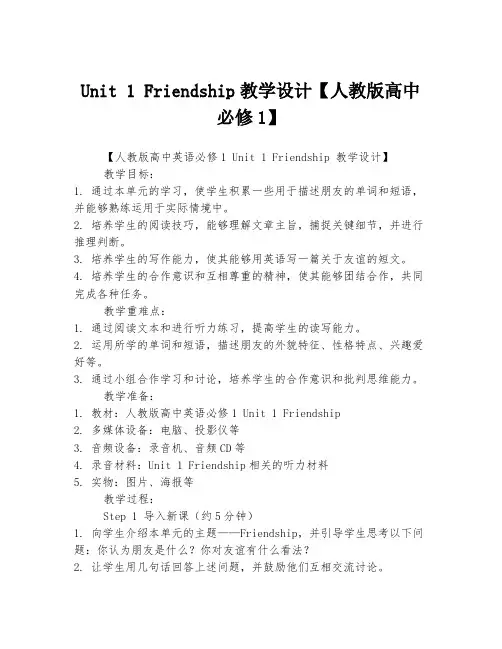
Unit 1 Friendship教学设计【人教版高中必修1】【人教版高中英语必修1 Unit 1 Friendship 教学设计】教学目标:1. 通过本单元的学习,使学生积累一些用于描述朋友的单词和短语,并能够熟练运用于实际情境中。
2. 培养学生的阅读技巧,能够理解文章主旨,捕捉关键细节,并进行推理判断。
3. 培养学生的写作能力,使其能够用英语写一篇关于友谊的短文。
4. 培养学生的合作意识和互相尊重的精神,使其能够团结合作,共同完成各种任务。
教学重难点:1. 通过阅读文本和进行听力练习,提高学生的读写能力。
2. 运用所学的单词和短语,描述朋友的外貌特征、性格特点、兴趣爱好等。
3. 通过小组合作学习和讨论,培养学生的合作意识和批判思维能力。
教学准备:1. 教材:人教版高中英语必修1 Unit 1 Friendship2. 多媒体设备:电脑、投影仪等3. 音频设备:录音机、音频CD等4. 录音材料:Unit 1 Friendship相关的听力材料5. 实物:图片、海报等教学过程:Step 1 导入新课(约5分钟)1. 向学生介绍本单元的主题——Friendship,并引导学生思考以下问题:你认为朋友是什么?你对友谊有什么看法?2. 让学生用几句话回答上述问题,并鼓励他们互相交流讨论。
3. 引入本单元的活动:学生们将在本单元学习如何谈论朋友,并通过小组合作练习互相了解彼此的朋友。
Step 2 阅读文本(约15分钟)1. 让学生阅读教材中的课文,并要求他们理解文章的主旨。
2. 学生们可以用关键词的形式记录下文章的主旨,并与同桌分享。
3. 引导学生找出文章中的生词和短语,并进行词义推测。
4. 学生们可以用自己的话对文章进行简单的概括,以检测其对文章的理解程度。
Step 3 听力练习(约15分钟)1. 播放与文章相关的听力材料,让学生进行听力理解练习。
2. 学生们可以用关键词的形式记录听到的信息,并与同桌分享。
高中英语 Unit1 Friendship第三课时教案 新人教版必修1

第三课时Learning about LanguageDiscovering Useful Words and Expressions (Page 4)第一步:学生独立完成本部分的练习;第二步:教师核对答案并对部分重难点进行讲解(对单元知识点的讲解可以结合文章中的典型例句和用法,让学生对课文内容和知识点在本单元中的用法掌握得更加牢固。
在讲解课文单词意思的时候要注意引导学生学会使用已经学过的单词和词组来解释生词的方法);难点词汇用法的学习,例如:1. add: add ... to;add to;add up to;eg. Will you please add some milk to my coffee?The little baby adds to our enjoyment at the party.All the money I have in my pocket adds up to $ 125.2. crazy: be crazy about / on; be crazy for sth. / sb.;eg. He was crazy about / on classic music when he was young.Many young college students are crazy for chances to go abroad for further education.My brother is crazy for the pop band ------ U2 and will never miss any of their performances.3. suffer: suffer sth. ; suffer from … ;eg. The company suffered great loss in the air crash.He often suffers from headaches at night.4. concern: concern sth.; be concerned about / for sb. / sth.;eg. This case concerns the group of people greatly.Our head teacher is concerned about our study and health all the time.5. according to ...;eg. According to the doctor, you should stay in bed for at least 2 days.I think we'd better set off as soon as possible according to the weather forecast.6. join: join sth.; join in sth.; join sb. in sth. / doing sth.;eg. He joined the Party when he was 18.Can I join the game?Will you join our team in playing football?7. dare: dare do ...; dare to do ...;eg. How dare you say I am an unfaithful man?If you dare do that again, I will make you feel sorry.He didn't dare to go there alone.I was greatly shocked that you dare to accuse him of dishonesty.第三步:学生通过完成练习册的配套练习(P41 Using words and expressions)巩固本单元的重点词汇和表达(教师可根据情况设计一些应用这些词汇和表达的句型或情景模式让学生进行练习以增强学习效果)。
最新人教版高中英语必修一unit1教案最终版
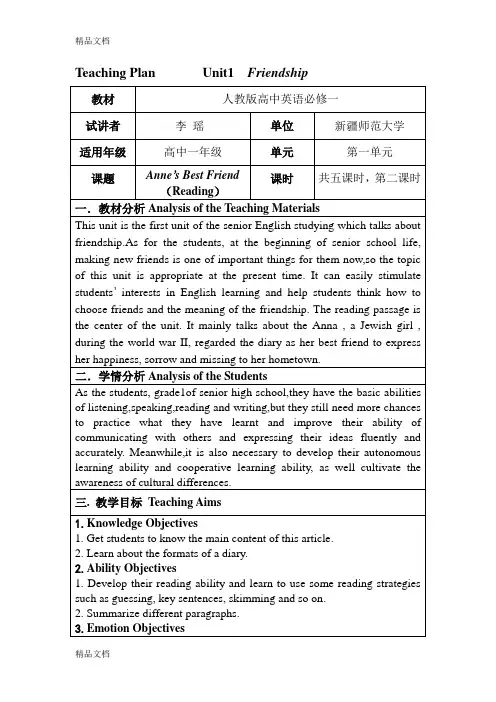
students’ interests in English learning and help students think how to
choose friends and the meaning of the friendship. The reading passage is
the center of the unit. It mainly talks about the Anna , a Jewish girl , during the world war II, regarded the diary as her best friend to express
三. 教学目标 Teaching Aims
1.Knowledge Objectives 1. Get students to know the main content of this article. 2. Learn about the formats of a diary. 2.Ability Objectives 1. Develop their reading ability and learn to use some reading strategies such as guessing, key sentences, skimming and so on. 2. Summarize different paragraphs. 3.Emotion Objectives
五.教法、学法与教具 Teaching and Learning Methods and Aids
1.Teaching Methods 1. Question-inquiry Teaching 2.Task-based Learning and Teaching 3.Analytic Discussion(pair work or group work)
人教版高一英语必修一Unit1-friendship全单元教案
Unit 1 friendshipParticipants: 靳燕,黄洋,董妮娅,仝亚军,李桂秀,吴晓,邹舍龙School: Tai Zhou Senior Middle Schoolaims and demands2.Suggested teaching notes1). Analyses of the teaching contents;This unit is about friendship, and nearly all the teaching materials center on it. Warming up---The questionnaire leads students to think and talk aboutfriendship, get to know the problems between friendsand seek solutions, which makes preparations for thefurther teaching in topics, background and vocabulary.Pre-reading---The questions prompt students to think critically aboutfriends and friendship in reality, alerting them to the factthat besides people, a diary can be a friend, too./Reading--- The diary by theJewish girl Anne gave a glimpse of her lifeduring her family’s shelter in Amsterdam from the GermanNazis’ killing in world war 2. she treats the diary as her best friend,and in it reveals her longing for a normal life and close contact withnature, which helps her get through the days.Comprehending---It helps students further understand the text by doingmultiple choices, questions and answers, andmatching.Learning about language---It teaches the important expressions andstructures and grammar: direct and indirect:speeches.Using language---The two letters, listening, questionnaire design, letterwriting and fun writing prepares students to furthertalk about friendship, especially the problems withmisunderstanding, and unfriendliness, thusstrengthening students’ abilities to practicelanguage, discover, and solve problems.Summing up---It summarizes the whole contents of this unit from the(aspects of topics, vocabulary and grammar.Learning tip--- This part encourages students to form the habit of writinga diary.Integrating skills--- The text introduces the way Hawaiians expressfriendship, to get students to realize the culturaldifferences in the values of friendship in additionits importance in all cultures.、2) Making of the teaching planThis unit centers on friends and friendship, exploring different types offriendship with particular attention to that one can develop with oneself,., the comfort and support one seeks from an imaginary friend.Students are expected to come to be truly aware of the qualities andconducts that make a good friend, display and develop the ability tocope with misunderstanding, conflicts and problems related tofriendship, and give advice on it. The concept that even an ordinary"thing can be a friend should break down the traditional belief in the interpersonal nature of friendship. Also, the comparison of similarities dissimilarities in friendship comprehension between the East and theWest leads students to know better the values of friendship in Westerns’eyes. All in all, this unit promises to unveil the true essence of friendshipand helps students to lead a more friendly and harmonious life.Thus, based on the theme, contents and teaching objectives, the whole3. Teaching plans for each periodPeriod 1 Warming-up and Speaking1. Teaching objectives:1) Target languageI (don’t) think…… I (don’t) think so. I (don’t) agree..I believe……That’s correct. In my opinion, ……2) Ability goalsa.Describe your friends in Englishb.Figure out the problems between friends and then find different ways to solvethe problems.3)Learning ability goalsa.To encourage students to think and talk about friends and friendship by usingsome phrases and structures.b.To learn to solve problems that may occur between friends.c. To cultivate the students to form the good habit of learning English in SeniorMiddle School.》2. Teaching important points:e the given adjectives and sentence structures to describe one of yourfriends.b.Learn to evaluate friends and friendship.3. Teaching difficult points:a.Work together with partners and describe one of your good friends.b.Discuss with partners and find out ways to solve the problems.!4. Teaching methodsa.Task-based teaching and learningb.Cooperative learningc.Discussion5. Teaching aids:CAI"6. Teaching procedures and ways:Step 1 Lead-in and Warming-upBefore the lesson, the teacher can arouse the students’ interests by showing a video of Auld Lang Syne .At the beginning of the first class, we can get the students to talk about their summer holidays. The students can talk freely as they like.1.How did you spend your summer holidays How did you feel Whatdid you do in your summer holidays What did you do in your sparetime2.What do you think of our new school Do you like it Could you saysomething about it3.Do you like making friends How do get in touch with your friends Doyou have many friends Where are they now Do you have any oldfriends in our school Have you made any new friends in our class !Step 2 Think it over1. Give a brief description of one of your friends. The following phrasesand structures may be helpful:His/Her name is ……He /She is …… years old.He /She likes …… and dislikes ……He /She enjoys …… and hates……He /She is very kind/friendly/……?When /Where we got to know each other.2. What types of friendship do you have Please tick them out. Then fill inthe blanks.girl friends boy friends pen friendslong -distance friends friends of the same agee-friends (friends over the internet) friends across generationsunusual friends like animals, books……1).______ is /are most important to you.2). You spend most of your free time with ____.`3). You will share your secrets with _____.4). When in trouble, you will first turn to _____.Step 3 Make a survey1. List some qualities of a good friend or your ideal friend. Have the students get into groups of four to find out what each has listed.Tell your partner your standards of good friends by using the following structure:I think a good friend sho uld (not) be……In my opinion, a good friend is someone who……1.…2.Have a member of each group report on what their lists have in common andlist them on the board.3.Ask the class whether or not they agree with all the qualities listed.4.Then have the students do the survey in the textbook.5.Have the students score their survey according to the scoring sheet on page 8.6.The teacher ask some students how many points they got for the survey andassess their values of friendship:★ 4~7 points: You are not a good frien d. You either neglect your friend’s needs or just do what he/she wants you to do. You should think more about what a good friend needs to do.★8~12 points: You are a good friend but you sometimes let your friendship become too important, or you fail to sh ow enough concern for your friend’s needs and feelings. Try to strike a balance between your friend’s needs and your own responsibilities.★13+ points: You are an excellent friend who recognizes that to be a good friend you need balance your needs and you r friend’s. Well done.?(You may also show your students the results above and let themselves self-reflect upon their own values of friendship)Step 4 Talking and sharing( work in pairs)1. If your best friend does something wrong, what will you doTry to use the following phrases:I (don’t) think…… I (don’t) think so.I (don’t) agree. I believe……That’s correct. In my opinion, ……2. What is a friendA British newspaper once offered a prize for the best definition(定义) of a friend. If you were the editior, choose the best one from the following entries(条目), and explain why.One who understands my silence.A friend in need is a friend indeed.Friends are just the people who share your happiness and sorrow.When you look at your watch at 4 am, but still know you can call!them and wake them up, and they’ll still want to talk to you ,that’sfriendship.To have a friend, you need to be a good friend.Step 5 Group work (output)The teacher can give each group one of these questions below to talk about. Then let the class share their ideas. It’s better to stimulate the students to express their own opinions about these questions.1.Do you think it is a good idea to borrow money from your friendWhy and Why not>2. What factors may cause the breakdown of a good friendship3. What can be your unusual friend besides human beings And whyStep 6 homework1.Write down a short passage about your ideas /the factors/your unusualfriends.2.Prepare for the new lesson.Period 2 Reading “Anne’s Best F riend”!1. Teaching objectives:1) To develop the students’ reading ability, learn to use some reading strategies such as guessing, key sentences, skimming and so on;2). To get the students to realize the importance of friends and friendship, and to tell true friends from false friends;3). To grasp some useful words and expressions in this passage, such as on purpose, be crazy about etc.;4). To learn the writing style of this passage.2. Teaching method: Task-based teaching~3). Teaching procedure:Step1. Please enjoy three pieces of music and find out what they are about.2 .Why do you think friends are important to you3. What do you think a good friend should be like List the good qualities a good friend should have .4. Have you ever considered making friends with animals, plants or even an object Why or why notStep}1. Try to guess what Anne’s friend is and what the passage is about by reading the title and having a quick at the pictures in this passage without reading it.2. Skimming the first two paragraphs to confirm your guessing.1) What was Anne’s best friend Why did she make friends with it2) Did she have any other true friends then Why3) What is the difference b etween Anne’s diary and those of most people4) Do you keep a diary What do you think most people set down in their diaries5) We are going to read one of Anne’s diaries .but before reading ,can you tell me what the diary is about with the help of one key sentence in the 2nd paragraph3. Reading of Anne’s diary…How she felt in the hiding placeTwo examples to show her feelings thenStepwould you miss most if you went into hiding like Anne and her family Give your reasons.workWork in groups to decide what you would do if your family were going to be killed just because they did something the Emperor did not like.Where would you plan to hide?How would you arrange to get food given to you every day'What would you do to pass the time------3. Discovering useful words and expressionsComplete the following sentences, using words and expressions from Reading1) She has grown _______ about computer games.2) Was it an accident or did David do it on _______3) From the beginning ,Paul made it clear that he would be ______ (完全地)in control.4) He used to work _______ even in the middle of winter.`5) Just the _______ of more food made her feel sick.6) You had better have a _________ talk with him.7) Born in a poor family, the manager _________ lots of hardships in his childhood.8) A diary is often kept to ________ what happens in people’s daily lives.Step about friends and friendshipare many proverbs about friends and friendship. Choose the one you agree with and explain why, then choose one you disagree with and explain why.A friend in need is a friend indeed."Friends are like wine; the older, the better.A friend to all is a friend to none.The same man cannot be both friend and flatterer(阿谀奉承者).False friends are worse than open enemies.Walking with a friend in the dark is better than walking alone in the light.2. We have talked about friends and friendship today, can you write one or two sentences to express your understanding of friends and friendship.Step :…1. Interview a high school student, a businessman, a police officer and a housewife to find out their opinions about friends and friendship. Write a report to share it with the whole class.2. Describe one of your best friends following the writing style of this passage. Ending: Let’s sing this song about friends togetherPeriod3 Grammar1.Teaching objectivesLearn to use direct speech and indirect speech:2. Teaching important pointSummarize the rules of Direct Speech and Indirect Speech.3. Teaching difficult pointLearn about the special cases in which the tenses shouldn’t be changed.4. Teaching methodsDiscussing, summarizing and practicing.|5. Teaching proceduresStep1 Lead inT: In the last lesson, we learned Anne Frank’s story. She is telling h er stories to two of her friends—you and Tom. Tom has something wrong with his ears,so you have to repeat Anne’s sentences, using indirect speech. Sometimes you explain Tom’s sentences to Anne.“I have to stay in the hiding place.” said Anne. →Anne said she had to stay in the hiding place.“Do you feel sad when you are not able to go outdoors” Tom asked Anne. →Tom asked Anne if/whether she felt sad when she was not able to go outdoors.'“I don’t want to set down a series of facts in a diary,” said Anne.→Anne said that she didn’t want to set down a series of facts in a diary.“What do you call your diary” Tom asked. →Tom asked what she called her diary.Ss go on this topic by themselves.Step2 GrammarT: Now let’s look at these sentences again. If we w ant to change Direct Speech into Indirect Speech, what should be changed:Ss discuss by themselves.Ss: sentence structures, tenses, pronouns, adverbials of time and place and verbs should be changed.T: Quite right. Look at the form on the screen. These are the rules.直接引语变成间接引语时,要注意以下几点:人称变化、时态变化、宾语从句要用陈述句语序。
人教版高中英语必修1教案Unit1Friendship
Unit 1 Friendship(1) 课题:Friendship (2) 教材分析与学生分析:本单元的中心话题是“友谊”,几乎所有的内容都是围绕这一中心话题展开的。
Warming Up部分以调查问卷的形式引导学生了解日常生活中朋友之间发生的真实问题以及解决这些问题的方法;Pre-Reading部分的几个问题启发学生对“友谊”和“朋友”进行思考,使学生明确不仅人与人之间可以做朋友,日记也可以成为人们的朋友;Reading部分Anne’s Best Friend以日记形式讲述了犹太女孩安妮的故事;Comprehending部分通过连句、多项选择和问答形式帮助学生对课文内容、细节进行更深入的理解; Using about Language 部分教学本课重点词汇和重点语法项目。
(3) 课时安排:The first period: Speaking: Warming Up andPre-Reading The second period: ReadingThe third period: GrammarThe forth Period:ListeningThe fifth period: Writing(4)教学目标:①知识与技能:Talk about friends and friendship; Practise talking about agreement and disagreement, giving advice and making decisions; Use direct speech and indirect speech; Learn to write an essay to express and support an opinion.②过程与方法:本单元在读前阶段就提出问题,让学生思考是不是只有人与人之间才能交朋友,然后在阅读中通过安妮的日记向学生说明我们也可以与动物及无生命的日记交朋友。
2019新人教版英语必修一全册教案教学设计
教案一:Unit 1 Friendship1. 课时安排本单元共分为4个课时,分别安排如下:第一课时:Section A 1a-1c第二课时:Section A 2a-2d第三课时:Section B 3a-4第四课时:Section B 5-72. 课时内容第一课时:Section A 1a-1c本课时主要目标是让学生通过听力和阅读理解,学习关于友谊的表达和句型。
首先通过1a部分的图片描述让学生对友谊的概念有初步的了解,然后通过1b的听力练习使学生能够听到不同人对友谊的看法,最后通过1c的阅读练习巩固所学内容。
第二课时:Section A 2a-2d本课时主要目标是让学生通过听力和口语练习,掌握能够表达友谊的句型和词汇。
通过2a的图片描述和2b的录音材料,学生可以听到不同人对友谊的表达,然后通过2c和2d的口语练习,学生可以有机会自己表达对友谊的看法。
第三课时:Section B 3a-4本课时主要目标是让学生通过听力和阅读理解,了解不同文化对友谊的看法。
通过3a和3b的录音材料,学生可以听到不同国家对友谊的表达,然后通过4的阅读练习,让学生更深入地了解不同文化对友谊的认识。
第四课时:Section B 5-7本课时主要目标是让学生通过听力和口语练习,掌握能够用英语表达友谊的能力。
通过5和6的听力材料,学生可以听到不同人对友谊的看法,然后通过7的口语练习,让学生能够自己用英语表达自己对友谊的看法。
3. 教学重点和难点本单元的教学重点是友谊的表达和句型,教学难点是如何让学生在实际生活中运用所学知识,进行口语交流。
4. 学情分析本单元学生的芳龄一般在14-16岁之间,他们对友谊这一主题可能会有一些自己的认识,但在英语表达方面可能还存在一定的困难。
因此在教学过程中需要及时发现学生的问题,并进行有针对性的辅导。
5. 教学方法本单元将主要采用任务型教学法,让学生通过实际的听力、阅读和口语练习来掌握所学内容。
新人教版高中英语必修1Unit1 Friendship教案
Unit 1 Friendship一、教材分析本单元的中心话题是“友谊”,几乎所有的内容都是围绕这一中心话题展开的。
“热身”(Warming Up)部分以调查问卷的形式引导学生了解日常生活中朋友之间发生的真实问题以及解决这些问题的方法。
“读前”(Pre-reading)部分的几个问题启发学生对“友谊”和“朋友”进行思考,使学生明确不仅人与人之间可以做朋友,日记也可以成为人们的朋友。
“阅读”(Reading)部分 ANNE'S BEST FRIEND以日记形式讲述了犹太女孩儿安妮的故事。
二战中为躲避纳粹的迫害,她和家人不得不藏身于荷兰阿姆斯特丹的一个小阁楼里,不能与外界接触,周围又没有可以推心置腹、与之深谈的朋友。
孤独之中她将日记作为朋友倾诉衷肠,在写日记的过程中寻求解决问题的办法。
“理解”(Comprehending)部分通过连句、多项选择和问答题的形式帮助学生对课文内容、细节进行更深入的理解。
“语言学习”(Learning about Language)部分教学本课重点词汇和重点语法项目。
“语言运用”(Using Language)部分的读两封信、听一段话、设计调查问卷、写信以及趣味写作,给学生提供了广阔空间去探讨友谊、友情,尤其是涉及到现实生活中被朋友误解、曲解,没有朋友的孤独寂寞等问题,既锻炼了学生的语言运用能力,又培养了学生发现问题、思考问题、解决问题的能力。
“小结”(Summing Up)部分引导学生从本单元的话题、词汇和语法等方面对所学内容进行总结(参考教学目的和要求栏目)。
“学习建议”(Learning Tip)部分鼓励学生养成写日记的习惯。
这样,一方面可以习得语言,另一方面还可以将日记作为自己的朋友表达感情与思想。
二、教学目标1. 语言知识掌握本单元词汇(单词35个,短语16)、语法(陈述句和疑问句的直接引语和间接引语)、及功能(Giving opinions)并了解话题(Friends and friendship & interpersonal relationships)2. 语言技能1)听能听懂劝谏信中的关键词,并能掌握说话者的忠告,领会其观点、态度和意图。
- 1、下载文档前请自行甄别文档内容的完整性,平台不提供额外的编辑、内容补充、找答案等附加服务。
- 2、"仅部分预览"的文档,不可在线预览部分如存在完整性等问题,可反馈申请退款(可完整预览的文档不适用该条件!)。
- 3、如文档侵犯您的权益,请联系客服反馈,我们会尽快为您处理(人工客服工作时间:9:00-18:30)。
Unit 1 Friendship(Listening and Writing)整体设计从容说课This is the sixth teaching period of this unit. We can first review some important language points the students learned in the last several periods. The emphasis of this period should be laid on listeni ng and writing. They are expansion of the topic of the text. Listening is about Lisa’s problem of making a friend with a boy. She asks Miss Wang for advice. Through listening and exercise, students learn how to give advice and the skill of giving advice. And also let them think about the problem of boy’s making friends with girls and girls with boys. And then design a task to ask students to give advice according to the different problems to develop their ability to solve the problems. All of these lay the foundation for the next task—writing. In this way, students feel that they have information to put out. And writing makes for the improvement of students’ writing ability, strengthening their comprehension of friendship.The two letters, listening and letter writing prepare students to further talk about friendship, especially the problems with misunderstanding, and unfriendliness, thus strengthen students’ abilities to practice language, discover, and solve problems.教学重点Develop the students’ listening ability, especially listening to and understanding key words and speakers’ intention and attitude.教学难点Develop the students’ writing skills by reading, discussing and writing a letter to give advice on friendship.教学方法1. Task-based teaching and learning2. Cooperative learning3. Discussion教具准备A tape recorder and other normal teaching tools三维目标Knowledge aims:1. Get the students to learn the following new words and useful expressions.teenager get along with fall in love advice questionnaire quiz editor communicate habit2. Get the students to know how to write a letter to offer advice.Ability aims:1. Enable the students to listen and understand the listening materials.2. Enable the students to write a letter to offer advice on friendship.Emotional aims:Develop and improve the students’ ability to help others solve such problems as how to communicate with people, how to make and be good friends, and so on.教学过程设计方案(一)→Step 1 RevisionHave a dictation about new words and expressions:ignore calm cheat loose concern suffer purpose entirely teenager trust hide away set down according to face to face go through a series of in order to walk the dog get along with add up→Step 2 Reading and listening(on Page 6)1. Lead-inTalk freely with the students to lead in the listening topic. Just like the following:Do you remember what Ann’s best friend is? Is it a man or a thing?Guess what my best friend is. (Say something about music, pets or plants. )So you see a man can make friends with anyone and anything.Then boys, would you like to make friends with girls? Girls, would you like to make friends with boys? What kind of girl would you like to make friends with? And what kind of boy would you like to make friends with?If you see a boy classmate makes a friend with a girl, will you say something about them behind? (If no, you are kind. If yes, you are a gossiper. )If you are that boy or girl, would you like to be gossiped about?2. ReadingRead the letter. Lisa has such a problem. She is asking you for help. What advice will you give? You are given 2 minutes to discuss in groups and then offer your group’s opinions.3. ListeningTell the students:Besides you, Lisa also asks Miss Wang of Radio for Teenagers for help. What advice does Miss Wang give to Lisa? Let’s listen to what she says.Listen for 3 times and do listening exercises. A fourth time for checking.4. Post-listeningTell the students:Do you think Miss Wang’s advice is helpful? Now suppose you are editors of Radio for Teenagers, here are some problems for you to offer advice.Show the following on the screen. Tell the students they can choose any problem as they like to write down their advice.1. I don’t have enough pocket money.2. I’m not satisfied with my app earance.3. My desk mate has lost a reference book, she thinks that I’m a thief.4. I work hard but I hardly make progress.5. I want to travel to Wu Zhen Town with my fiends this weekend, but my parents don’t allow me to go.6. I don’t like the way Mr. Li teaches us English, so I’m not interested in English any longer.7. My mother has just given birth to my little brother. I’m worried that the baby will rob me of my parents’ love and even everything.8. I quarreled with my best friend 3 days ago. Up to no w, we haven’t said a word to each other.9. I’d like to be monitor, but at the same time I doubt whether I have such ability.10. I’m often late for school. The teacher is so angry that he threatens that if I’m late again, I will be dismissed.Ask several students to report their advice.→Step 3 Writing (on Page 7)1. Pre-writing1)Read a letter from a student named Xiaodong. Go through the directions on Page 7.2)Brainstorm with a partner about ways to change the situation. Make a list of the ideas and give reasons.3)Decide which are the best ideas and put them into the right order.2. While-writingAsk the Ss to write a letter to Xiaodong and give him some advice.Suggested steps:1)Read the sample and the expressions.2)Begin to write the letter to Xiaodong.3)Revise your letter by yourself.4)Exchange your writing paper with your partners and correct the mistakes you have made.5)Get back your own writing paper and write the letter again.3. Post-writingHave a discussion in groups.1)Can you give Xiaodong some good advice?2)Is your letter well developed?3)Are your ideas well organized to the point?4)Do you have a good choice of words and idioms in your writing?5)Do you get a good mastery of complex structures of language?6)What kind of mistakes have you made in your writing? What can you do to avoid such mistakes?Choose some students’ writing paper and show them in the class. Ask the Ss to correct the mistakes together and also learn from some good writings.→Step 4 WorkbookWriting task (on Page 46)1. Read the proverbs, explain them and ask the students to choose some they agree with and some they disagree with and explain why.2. Discuss with their partner and then write a passage according to the sample story and “Analyzing the structure”.→Step 5 Homework1. Finish off the workbook exercises.2. Write a short passage about your friend.板书设计Unit 1FriendshipListening and Writingnew words and expressions writing stepsteenager get along with fall in love advice questionnaire quiz editor communicate habit 1. Make a list of the information.2. Begin to write the letter.3. Revise your letter.. . .活动与探究Get the students to hold a group writing competition out of class. Ask them to describe one of their friends—their appearance, personality, hobbies, etc. This activity makes for the improvement of students’ writing ability, strengthening their comprehension of friendship, and also developing their cooperative spirit and sense of competition.Sample description:I have a few good friends, but I think Miki is my best friend. We both read a lot and we’re very interested in films. We spend a lot of time watching videos and talking about films and books. She works hard. She is very helpful. Whenever I am in trouble, she will help me out. . .。
